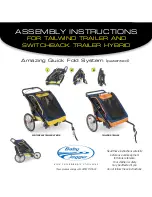
54
b
a
Do not actuate the lockout function (of the suspension fork)
when riding over rough terrain, but only when riding over
smooth terrain (roads, smooth tracks)
(a)
.
Do not turn any screws on your rear shock in the vague hope of
adjusting it somehow. You could release the fastening mecha-
nism, thus causing an accident. All manufacturers normally
mark adjustment devices with a scale or “+” and “-“ signs
(b)
.
Suspension fork manufacturers normally include instructions
with their deliveries. Read them carefully before changing any
settings or doing any maintenance work on your rear shock.
A too strong damping of the fork can result in a sluggish
rebound movement with a suspension fork that will not recover
when exposed to a quick series of impacts.
Risk of accident!
Do not ride your bicycle, if the suspension fork bottoms out.
This could damage the suspension fork itself as well as the
frame.
When mounting a new front tyre, make sure there is enough
clearance between tyre and fork crown as the fork compresses
entirely. The front wheel might get jammed.
Risk of accident!
9.2.3 Adjusting the Travel.
The travel of some suspension fork models allow travel adjustment.
With some models reducing the travel makes for an easier uphill riding.
A reduced travel may result in a modified spring characteristic of the fork
making the fork either softer or firmer. This can reduce the comfort of
suspension.
With other models, changing the travel does not result in a modified
spring characteristic. The suspension fork provides an identic comfort of
suspension with a however clearly reduced travel.
Do not ride with a reduced travel over rough terrain or downhill!
For more information on adjusting the travel, please read the
enclosed instructions of the suspension fork manufacturer!
















































